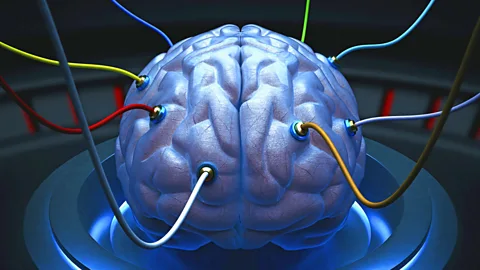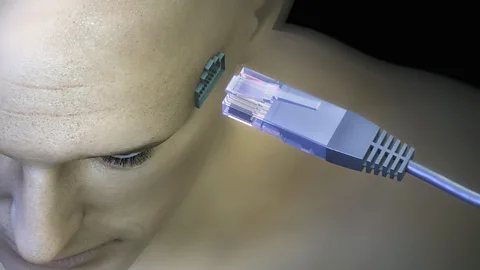‘I emailed a message between two brains’


Could we one day hook up our brains to the internet? Rose Eveleth investigates a claim for the ‘first’ online message sent between two minds.
As internet connections become faster and more of the devices we carry help keep us online, it can sometimes feel like we’re on the verge of spontaneous email communication. I send an email, you receive it, open it, and respond – all in a matter of seconds. Regardless of whether you think near-instant communication is a good thing or not, it’s certainly happening. Not long ago we routinely waited days or weeks for a letter – today even waiting hours for a reply can feel like an eternity.
Perhaps the ultimate way to speed up online communication would be to push towards direct brain-to-brain communication over the web. If brains were directly connected, there would be no more need for pesky typing – we could simply think of an idea and send it instantly to a friend, whether they are in the same room or half the world away. We’re not there yet, of course, but a recent study took a first step in that direction, claiming direct brain-to-brain communication over the internet between people thousands of miles from one another.
The work is simply a proof of concept, as Giulio Ruffini, one of the researchers on the project – and CEO of Starlab, based in Barcelona – is quick to explain. The team did not, as some reported, send words or thoughts or emotions from one brain to another. Instead they did something much simpler.

Here’s how it worked. One subject – in this case a man in Kerala, India – was fitted with a brain-computer interface that records brainwaves through the scalp. That person was then instructed to imagine they were moving either their hands, or their feet. If he imagined moving his feet, the computer recorded a zero. If he imagined moving his hands, it recorded a one.
This string of zeros and ones was then sent through the internet to a receiver: a man in Strasbourg, France. He was fitted with something called a TMS robot – a robot designed to deliver strong but short electrical pulses to the brain. When the sender thought about moving his hands, the TMS robot zapped the receiver’s brain in a way that made him see light – even though his eyes were closed. The receiver saw no light if the sender thought about moving his feet.
To make the message more meaningful, the researchers came up with a cipher: one string of zeros and ones (or hands and feet) meant “hola” and another meant “ciao”. The receiver – who had also been taught the cipher – could then decode the signal of lights to interpret which word the sender had sent.
Deep concentration
This might sound simple, but at each stage there are complications. The sender has to concentrate extremely hard to focus only on imagining moving their hands or feet. Any other activity in the brain can cloud the signal, and make it hard to pick up the message. In fact, the sender had to be trained in how to do this properly.

The whole process isn’t fast, either. The researchers estimated that from brain to brain the transmission speed was about two bits (a zero and a one) per minute. So to get even a simple message from one brain to another would take a while. But when it happened, and it worked, Ruffini says it was exciting.
“I mean, you can look at this experiment in two ways,” he says. “On the one hand it’s quite technical and a very humble proof of concept. On the other hand, this was the first time it was done, so it was a little bit of a historical moment I suppose, and it was pretty exciting. After all the years thinking about it and finding the means to do it, it felt pretty good.”
Just a stunt?
There is actually some debate over whether the experiment really does represent a first. Last year, a team at Harvard hooked up a man’s brain to a rat’s tail, and he was able to make the tail twitch just by thinking. Also last year, a group at the University of Washington was able to create a brain-to-brain interface in which a sender gained some control over a receiver’s motor cortex, allowing him to send messages that caused the receiver’s hand to subconsciously strike a keyboard. Consequently, one scientist told IEEE Spectrum he thought Ruffini’s work was “pretty much a stunt”, and had “all been shown before”. But Ruffini’s experiment is certainly the first in which a brain-to-brain connection was attempted over such great a distance, and the first time the receiver was consciously interpreting the signal.

And Ruffini has bigger dreams. He wants to transmit feelings, sensations, and complete thoughts between brains. “The technology is very limited right now, but some day can be very powerful,” he says. “Some day we will transcend verbal communications.”
There are advantages to doing so, he says. Receiving another’s thoughts directly into your brain might allow people to more effectively put themselves in someone else’s shoes and understand how they feel, which could make the world a better place. “I think most of the world’s problems stem from the fact that we have different viewpoints and we don’t understand how other people see or feel about the world,” he says, “Being able to actually feel what other people are feeling, it would change a lot.” He even talks about applying the method to animals, to understand their world and feelings.

Before they can send fully formed concepts, the next step for the team is to try to transmit something more complicated than a one or a zero. This might involve stimulating the brain at multiple sites, and moving beyond using the perception of light as the signal. “The way we have encoded information in the brain, it’s distributed, there is not a single place where the word ‘hello’ is stored,” says Ruffini. To transmit language directly, he says, the researchers will have to figure out how to stimulate the networked brain in a new way. And if they want to send sensations, they’ll have to figure out how to stimulate those segments of the brain too. What makes the task even harder is the fact that the researchers want to do this stimulation externally, without invasive – but more precise – brain implants.
Of course, with this kind of power comes danger too. Anything sent over the internet can be hacked and tracked. The ability to send messages directly into a person’s brain is, to some, a terrifying concept. “It can potentially be some day used in a negative way – you could try to take control of [somebody’s] motor system,” says Ruffini. But he points out that researchers are a long way from being able to do anything even remotely so sophisticated.
Still, it remains an intriguing thought that one day, many decades from now, you might be digesting emails, messages or even an article like this one directly into your mind.